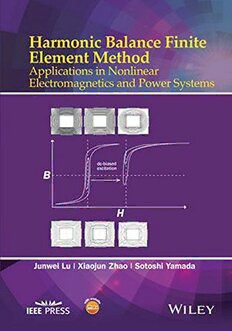Table Of ContentHARMONIC BALANCE
FINITE ELEMENT
METHOD
HARMONIC BALANCE
FINITE ELEMENT
METHOD
APPLICATIONS IN NONLINEAR
ELECTROMAGNETICS AND
POWER SYSTEMS
Junwei Lu, Xiaojun Zhao and Sotoshi Yamada
Thiseditionfirstpublished2016
©2016JohnWiley&SonsSingaporePte.Ltd
RegisteredOffice
JohnWiley&SonsSingaporePte.Ltd.,1FusionopolisWalk,#07-01SolarisSouthTower,
Singapore138628.
Fordetailsofourglobaleditorialoffices,forcustomerservicesandforinformationabouthowtoapplyfor
permissiontoreusethecopyrightmaterialinthisbookpleaseseeourwebsiteatwww.wiley.com.
AllRightsReserved.Nopartofthispublicationmaybereproduced,storedinaretrievalsystemor
transmitted,inanyformorbyanymeans,electronic,mechanical,photocopying,recording,scanning,or
otherwise,exceptasexpresslypermittedbylaw,withouteitherthepriorwrittenpermissionofthePublisher,
orauthorizationthroughpaymentoftheappropriatephotocopyfeetotheCopyrightClearanceCenter.
RequestsforpermissionshouldbeaddressedtothePublisher,JohnWiley&SonsSingaporePte.Ltd.,
1FusionopolisWalk,#07-01SolarisSouthTower,Singapore138628,tel:65-66438000,fax:65-66438008,
email:enquiry@wiley.com.
Wileyalsopublishesitsbooksinavarietyofelectronicformats.Somecontentthatappearsinprintmaynot
beavailableinelectronicbooks.
Designationsusedbycompaniestodistinguishtheirproductsareoftenclaimedastrademarks.Allbrand
namesandproductnamesusedinthisbookaretradenames,servicemarks,trademarksorregistered
trademarksoftheirrespectiveowners.ThePublisherisnotassociatedwithanyproductorvendormentioned
inthisbook.Thispublicationisdesignedtoprovideaccurateandauthoritativeinformationinregardtothe
subjectmattercovered.ItissoldontheunderstandingthatthePublisherisnotengagedinrendering
professionalservices.Ifprofessionaladviceorotherexpertassistanceisrequired,theservicesofacompetent
professionalshouldbesought.
LimitofLiability/DisclaimerofWarranty:Whilethepublisherandauthorhaveusedtheirbesteffortsin
preparingthisbook,theymakenorepresentationsorwarrantieswithrespecttotheaccuracyorcompleteness
ofthecontentsofthisbookandspecificallydisclaimanyimpliedwarrantiesofmerchantabilityorfitness
foraparticularpurpose.Itissoldontheunderstandingthatthepublisherisnotengagedinrendering
professionalservicesandneitherthepublishernortheauthorshallbeliablefordamagesarisingherefrom.
Ifprofessionaladviceorotherexpertassistanceisrequired,theservicesofacompetentprofessional
shouldbesought.
LibraryofCongressCataloging-in-PublicationData
Names:Lu,Junwei,author.|Zhao,Xiaojun,(Electricalengineer),author.|Yamada,Sotoshi,author.
Title:Harmonicbalancefiniteelementmethod:applicationsinnonlinearelectromagneticsand
powersystems/JunweiLu,XiaojunZhao,andSotoshiYamada.
Description:SolarisSouthTower,Singapore:JohnWiley&Sons,Inc.,[2016]|
Includesbibliographicalreferencesandindex.
Identifiers:LCCN2016009676|ISBN9781118975763(cloth)|ISBN9781118975787(epub)
Subjects:LCSH:Electricpowersystems–Mathematicalmodels.|
Harmonics(Electricwaves)–Mathematics.|Finiteelementmethod.
Classification:LCCTK3226.L7572016|DDC621.3101/51825–dc23
LCrecordavailableathttps://lccn.loc.gov/2016009676
Setin10.5/13ptTimesbySPiGlobal,Pondicherry,India
1 2016
This book is dedicated to my wife Michelle, without her support I would never
complete this book, and in memory to my parents.
– Junwei Lu
This book is dedicated to my wife Weichun Cui, since she has helped me a lot during
the writing of this book. I also would like to express my gratitude to my beloved
parents, who have always supported me.
– Xiaojun Zhao
Contents
Preface xii
About the Companion Website xv
1 Introduction to Harmonic Balance Finite Element Method (HBFEM) 1
1.1 Harmonic Problems in Power Systems 1
1.1.1 Harmonic Phenomena in Power Systems 2
1.1.2 Sources and Problems of Harmonics in Power Systems 3
1.1.3 Total Harmonic Distortion (THD) 4
1.2 Definitions of Computational Electromagnetics and IEEE Standards
1597.1 and 1597.2 7
1.2.1 “The Building Block” of the Computational Electromagnetics
Model 7
1.2.2 The Geometry of the Model and the Problem Space 8
1.2.3 Numerical Computation Methods 8
1.2.4 High-Performance Computation and Visualization (HPCV)
in CEM 9
1.2.5 IEEE Standards 1597.1 and 1597.2 for Validation of
CEM Computer Modeling and Simulations 9
1.3 HBFEMUsedinNonlinearEMFieldProblemsandPowerSystems 12
1.3.1 HBFEM for a Nonlinear Magnetic Field With Current Driven 13
1.3.2 HBFEM for Magnetic Field and Electric Circuit
Coupled Problems 14
1.3.3 HBFEM for a Nonlinear Magnetic Field with Voltage Driven 14
1.3.4 HBFEM for a Three-Phase Magnetic Tripler Transformer 14
viii Contents
1.3.5 HBFEM for a Three-Phase High-Speed Motor 15
1.3.6 HBFEM for a DC-Biased 3D Asymmetrical Magnetic
Structure Simulation 15
1.3.7 HBFEM for a DC-Biased Problem in HV Power Transformers 16
References 17
2 Nonlinear Electromagnetic Field and Its Harmonic Problems 19
2.1 Harmonic Problems in Power Systems and Power Supply Transformers 19
2.1.1 Nonlinear Electromagnetic Field 19
2.1.2 Harmonics Problems Generated from Nonlinear Load and
Power Electronics Devices 21
2.1.3 Harmonics in the Time Domain and Frequency Domain 25
2.1.4 Examples of Harmonic Producing Loads 28
2.1.5 Harmonics in DC/DC Converter of Isolation Transformer 28
2.1.6 Magnetic Tripler 33
2.1.7 Harmonics in Multi-Pulse Rectifier Transformer 35
2.2 DC-Biased Transformer in High-Voltage DC Power
Transmission System 38
2.2.1 Investigation and Suppression of DC Bias Phenomenon 38
2.2.2 Characteristics of DC Bias Phenomenon and Problems to
be Solved 40
2.3 Geomagnetic Disturbance and Geomagnetic Induced Currents (GIC) 41
2.3.1 Geomagnetically Induced Currents in Power Systems 42
2.3.2 GIC-Induced Harmonic Currents in the Transformer 46
2.4 Harmonic Problems in Renewable Energy and Microgrid Systems 47
2.4.1 Power Electronic Devices – Harmonic Current and
Voltage Sources 48
2.4.2 Harmonic Distortion in Renewable Energy Systems 50
2.4.3 Harmonics in the Microgrid and EV Charging System 52
2.4.4 IEEE Standard 519-2014 56
References 58
3 Harmonic Balance Methods Used in Computational Electromagnetics 60
3.1 Harmonic Balance Methods Used in Nonlinear Circuit Problems 60
3.1.1 The Basic Concept of Harmonic Balance in a Nonlinear Circuit 60
3.1.2 The Theory of Harmonic Balance Used in a Nonlinear Circuit 63
3.2 CEM for Harmonic Problem Solving in Frequency, Time and
Harmonic Domains 65
3.2.1 Computational Electromagnetics (CEM) Techniques and
Validation 65
3.2.2 Time Periodic Electromagnetic Problems Using the
Finite Element Method (FEM) 66

